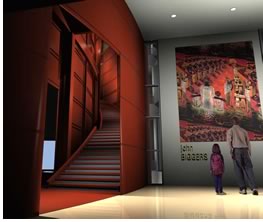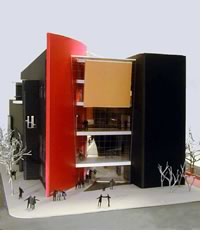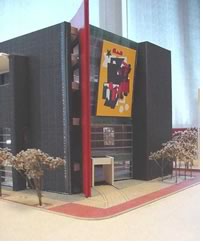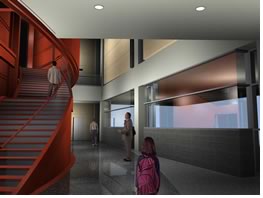

Associate Editor
A new African American history museum slated for Baltimore's Inner Harbor will seek to embody the character, pride, struggle, and accomplishments of Maryland's African American people. Beginning with a "strong commitment to an emotional architectural response," the planned Maryland Museum of African American History and Culture will be designed to reflect the seven concepts that relate to key aspects of African American identity: spirituality, joy, vibrancy, resilience, the power of knowledge, values and principals, the importance of family, and cultural continuity.
 The
architecture "embraces the duality" of "celebration and
disappointment, flight and perseverance, joy and pain," the designers
said. It is "very spirited and is filled with many layers of meaning,"
reflecting the common aspects of African Americans in Maryland, said Gary
Bowden, FAIA. Bowden is now a professor of practice at the University
of Maryland, after retiring from RTKL, Baltimore. He has extended his
ties with RTKL to finish the project, which is slated for completion in
late 2003 or early 2004.
The
architecture "embraces the duality" of "celebration and
disappointment, flight and perseverance, joy and pain," the designers
said. It is "very spirited and is filled with many layers of meaning,"
reflecting the common aspects of African Americans in Maryland, said Gary
Bowden, FAIA. Bowden is now a professor of practice at the University
of Maryland, after retiring from RTKL, Baltimore. He has extended his
ties with RTKL to finish the project, which is slated for completion in
late 2003 or early 2004.
The museum sits on a narrow site near Baltimore's active Inner Harbor. When completed, it will house a performing arts auditorium, gallery space, resource center, oral history recording studio, classrooms and educational facilities, cafe, museum store, and administrative support space.
Partnership
The five-story, $18 million, 72,000-square-foot structure is being designed
by RTKL, whose flagship office is in Baltimore, and The Freelon Group,
whose main office is in Research Triangle Park, N.C. The two firms teamed
up for what Bowden called a "storybook project."
 The
team, officially The Freelon/RTKL joint venture, was chosen over five
other groups competing for the project. The team was formed based on the
relationship of Bowden and Phil Freelon, AIA, president of the Freelon
Group Architects. As highly accomplished architects who are African American,
their personal and professional lives have crossed at many points during
the years, Freelon and Bowden said. There had been some general discussions
about working together, but it was Baltimore's African American history
museum that piqued their interest and again got them thinking about collaboration.
The
team, officially The Freelon/RTKL joint venture, was chosen over five
other groups competing for the project. The team was formed based on the
relationship of Bowden and Phil Freelon, AIA, president of the Freelon
Group Architects. As highly accomplished architects who are African American,
their personal and professional lives have crossed at many points during
the years, Freelon and Bowden said. There had been some general discussions
about working together, but it was Baltimore's African American history
museum that piqued their interest and again got them thinking about collaboration.
Bowden said it was important to him and RTKL that they put forth a diversified team to design what will be the nation's second-largest African American history museum. The Freelon Group, which was the recipient of AIA North Carolina's 2001 Firm Award, had developed a reputation for "high quality, high design, and delivery" along with recent experience and plaudits on several other cultural institutions, both in North Carolina, and nationally. Freelon's firm, which is also working on high-profile projects in San Francisco, Los Angeles, and Philadelphia, saw the partnership primarily as an opportunity to enhance the team, but also to have a local component involved in the design, engineering, and construction phases. The partnership is not in name only: the firms are splitting the fees in half and working closely together to make the process seamless for the client.
Freelon advised firms interested in collaboration to seek out partners with common values and principles so that there is chemistry involved in the strategic alliance. Once that is accomplished, he said, all other things fall into place.
 Layers
of meaning
Layers
of meaning
The design was born from listening closely to the client, working with
a conceptual vision, and executing a scheme within the space set aside
for the new cultural center, Freelon said. Situated in an urban area,
it must compete with all the other cultural and entertainment opportunities
downtown Baltimore offers.
As a result, Bowden said, the architecture is strong, bold, and "very spirited" and visually explores the common aspects of African American experience in Maryland. The five-story building is designed around a central core lit by an atrium that accentuates a red "intervention wall" that is present on all five levels of the museum. The wall "flashes through" a black box of a building, Bowden said. The architects said the wall's symbolism is manifold and represents the dichotomy of the African American experience in Maryland. Among other emotions and concepts, it represents the pain, suffering, struggles, and conflicts encountered by African Americans as they settled in the U.S.; the effort to fit into society; and the creativity, vibrancy, and passion African Americans bring to Maryland and the U.S. The colors are also derived from the Maryland flag. Like the African American experience, all the circulation paths are oriented back toward the core red wall.
 The
walls will also feature screened images of African Americans who have
contributed to Maryland's history, as both historical and artistic elements.
The
walls will also feature screened images of African Americans who have
contributed to Maryland's history, as both historical and artistic elements.
The project manager is Maryland's Department of General Services. Other members of the design team include Mahan Rykiel Associates, landscape architects, and Delon Hampton Associates, civil engineers. The museum's programs will be part of the curriculum for Maryland public school students.
The firms have obvious mutual admiration for each other's strengths and the level of expertise that they bring to the joint venture. The joint venture is also emblematic of the relationships that can be formed by being active in the profession and open to new ideas and ways to practice. The project is evidence of the "lofty idealism" that the design team itself represents and how that idealism can be harnessed into exceptional architecture.
Copyright 2002 The American Institute of Architects. All rights reserved.
![]()
|
Read more about RTKL's worldwide offices and its multidiscipline portfolio. The Freelon Group is an architecture and interior design firm with offices in Raleigh-Durham and Charlotte. Photos by David Whitcomb. |
|